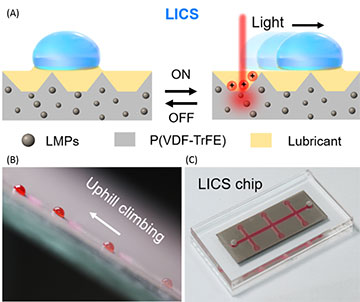Slippery lubricant-infused porous surfaces platform. Top panel illustrates the droplet-manipulation schematic of the light-induced charged slippery surface (LICS). Bottom-left panel shows a dyed water droplet moving upward on a LICS under near-infrared illumination. Bottom-right panel displays closed LICS microfluidic chip. [Image: SIAT] [Enlarge image]
In the past decade, interfacial materials known as slippery lubricant-infused porous surfaces (SLIPS)—which combine surface roughness with a slippery liquid—have attracted considerable research interest. Their super-repellant properties offer enhanced functionalities such as self-healing, anti-fouling, anti-icing and anti-evaporation.
Now, researchers in China have developed a new class of slippery material activated by light that enables precise control of liquid droplets (Sci. Adv., doi: 10.1126/sciadv.abp9369). The novel surfaces demonstrate superior performance compared to conventional SLIPS, with faster manipulation speeds, antigravity motion and generality to a wide range of liquids.
Advantages of both solid and lubricant
Scientists have explored the feasibility of SLIPS for a diverse range of applications, including anti-biofouling for marine optical instruments, corrosion protection with self-healing ability and passive ice removal. While studies have also looked at using SLIPS for droplet manipulation, the presence of a lubricant layer screens the underlying solid surface, preventing the use of a structural or surface-charge gradient.
Xuemin Du, an engineering professor at Shenzhen Institute of Advanced Technology (SIAT), Chinese Academy of Sciences, and his colleagues wanted to harness the dual advantages of both solid and lubricant for the remote control of liquid droplets, particularly within biomedical domains. To this end, they created a light-induced charged slippery surface (LICS) that incorporates liquid metal particles, copolymer and microstructures for trapping lubricant. Illumination of a LICS with an 808-nm laser results in a temperature gradient and, due to extra positive charges, a nonuniform electric field. The two forces then collectively push or pull the droplet.
“The light-induced charge regeneration in LICS exhibits superior efficiency, reliability and stability, eliminating the unwanted screening effect caused by the presence of lubricant,” said Du, in a press release accompanying the research.
Toward biomedical applications
The LICS has several advantages over passive SLIPS and superhydrophobic surfaces, such as fast speed, antigravity motion with high spatiotemporal resolution, a large range of droplet volumes and high generality to various liquids—even biological liquids, like blood.
The researchers tested the LICS platform for biomedical applications, creating various morphologies using hydrogel beads in an open environment and analyzing closed-channel microfluidics. Furthermore, they successfully manipulated and fused droplets containing a reactive-oxygen-species-sensitive fluorescence probe and a suspension of stem cells in a closed LICS chip.
“The simple design, portable operation and unique features of the LICS would open new avenues for the next-generation interfacial materials and microfluidics, bringing wide possibilities for chemical and biomedical applications,” said Du.


